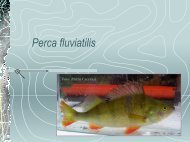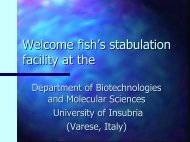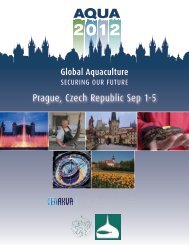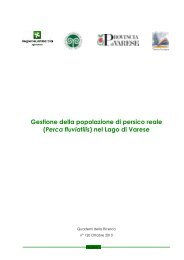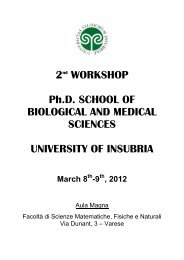Dicentrarchus labrax - DBSM
Dicentrarchus labrax - DBSM
Dicentrarchus labrax - DBSM
You also want an ePaper? Increase the reach of your titles
YUMPU automatically turns print PDFs into web optimized ePapers that Google loves.
Taxonomy Kingdom: Animalia Phylum: Chordata Subphylum: Vertebrata Superclass: Osteichthyes Class: Actinopterygii (spiny rayed fishes) Subclass: NeopterygiiInfraclass: TeleosteiSuperorder: AcanthopterygiiOrder: PerciformesSuborder: PercoideiFamily: Moronidae Genus: <strong>Dicentrarchus</strong> Gill, 1860Species: <strong>Dicentrarchus</strong> <strong>labrax</strong>
Morphology5 cmFoto: P.CeccuzziMax. weight: 9 to 10 kg (19.8 to 22 lbs); Full length: ca. 1 m.The body, covered by large scales, is usually silver-blue on theflanks; belly is white or pale yellow. Color varies with age andhabitat. Younger individuals show black spots, that usuallydisappear by 1 year of age. The head is quite pointed, blunterin older fishes. (Wheeler 1975, Pickett and Pawson 1994).
HabitatThe European sea bassinhabits marine andestuarine coasts, aroundcrops of rocks.They can survive inalmost fresh water.Migratory behaviour indeeper water is typical ofadults and linked toenvironmental andseasonal conditions.Younger and spawningfemales are found only ininshore areas.Photo: Courtesy NASA/JPL-Caltech
Behaviour and feedingThe European sea bassform shoals despite theiraggressive and territorialbehaviour.Migratory behaviour:shown under selectedenvironmental andphysiological conditions.Swimming power andspeed: high, even instrong turbulence;increasing with size.Feeding: Sea bass is apredatory species,feeding on small pelagicfishes, sand smelts andbottom-living species.(Foto: P.Ceccuzzi)
Flashing, feeding, aggressivebehaviourFlashing: rubbing one flank whileon the bottom, so that a silveryflash suddenly appears.Aggressive posture: defensive,showing as many spines andmaking himself as larger aspossible.When threatened, can occasionallystay buried in a soft bottomsubstrate, for 30-60 seconds, toescape predators.Foto: P.Ceccuzzi
Reproduction Mode of reproduction: dioecism, external fertilization. Spawning: once a year, from February to July.(Temperature must be kept between 9°C and 15°C). Number of eggs: 250,000 –500,000 (in relation towater temperature and female body weight) Eggs: planktonic, spherical, transparent, non sticky,hatching 3 –9 days after fertilization. Larval stage: 46 days (at 16°C), growing from 60 to1000 µg. Melanophores are evident as a continousline from the snout to the base of the caudal fin.Dorsal and lateral row of melanophores only in theposterior part of the tail. Young fishes drift from open sea inshore, andcomplete mature in 4-5 years inhabiting coastalhabitats.
Diseases: bibliographyBacterial diseases : Edwardsiellosis, Epitheliocystis.Parasitic:• Isopoda : Cymothoidae (Ceratothoa oestroides, C. steindachneri J APPLICHTHYOL, 2004, 20: 314-317; SCI MAR, 2004, 68:159-163; J FISH DIS, 2003, 26: 401-406;BULL EUR ASSN FISH P, 2001, 21: 26-29 .• Myxozoa: Sphaerospora dicentrarchi , S.testicularis, PentacapsulacutaneaFOLIA PARASIT, 2004, 51: 208-210; SCI MAR, 2004, 68: 159-163; SCI MAR, 2004, 68: 159-163; J EUKARYOT MICROBIOL, 2001, 48: 395-413• Monogenea: Diplectanum aequansBULL EUR ASSN FISH P, 2001, 21: 241-245;• Lernanthropus kroyeri: DIS AQUAT ORGAN, 2003, 57: 177-180 Philasteridesdicentrarchi: DIS AQUAT ORGAN, 2002, 49: 191-197• Parasites of wild sea bass <strong>Dicentrarchus</strong> <strong>labrax</strong> from Norway: DISAQUAT ORGAN, 2002, 48: 209-212• Cymothoid isopod parasites in aquaculture: a review and case studyof a Turkish sea bass (<strong>Dicentrarchus</strong> <strong>labrax</strong>) and sea bream (Sparusauratus) farm: DIS AQUAT ORGAN, 2001, 46: 181-188



